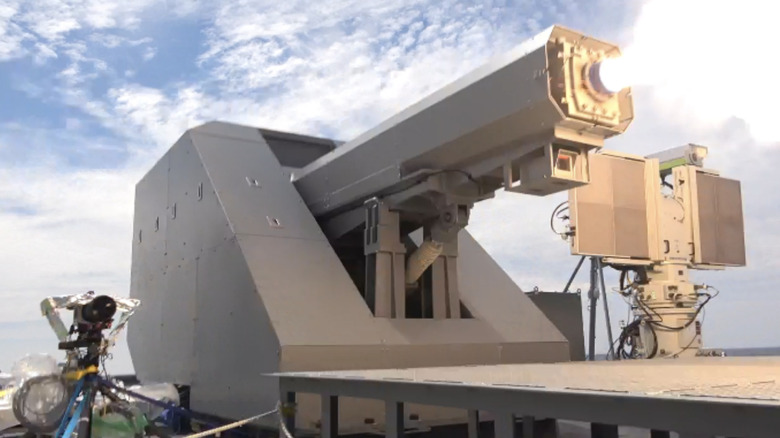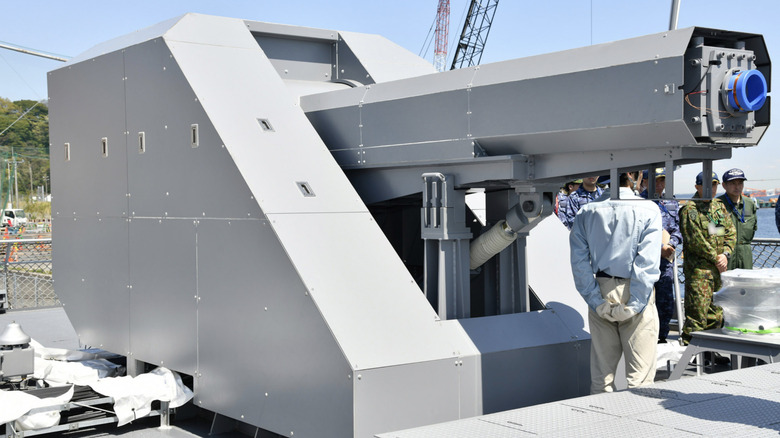Japan's Massive Ship-Mounted Railgun Just Fired A History-Making Shot
Japan reached a new defense milestone in the summer of 2025 after successfully test-firing a high-power electromagnetic railgun at a moving naval target. According to the Acquisition Technology & Logistics Agency's (ATLA) Instagram page, where it released images from the test, "It's the first time that a ship-mounted railgun was successfully fired at a real ship," bringing it a step closer to becoming the first nation to deploy next-gen railgun systems. ATLA first tested the weapon in 2023, following years of research and engineering validation that began in 2016. The prototype that was tested between June and July 2025 is installed on the JS Asuka vessel.
#ATLA conducted the Ship-board #Railgun Shooting Test from June to early July this year with the support of the Japan Maritime Self-Defense Force. It's the first time that a ship-mounted railgun was successfully fired at a real ship.#Ground_Systems_Research_Center #JMSDF #Asuka pic.twitter.com/XuULOOTBgO
— Acquisition Technology & Logistics Agency (@atla_kouhou_en) September 10, 2025
The idea of railguns has been around since World War I, and numerous countries have explored it, including the U.S. Compared to a conventional gun, which relies on fire and gas as the propellant for projectiles, railguns utilize electromagnetic push for accelerating a projectile. Compared to a typical gunpowder-based launcher, a railgun promises significantly higher muzzle velocity, deeper penetration, and higher range.
A railgun is significantly cheaper than current defensive systems, with a single round costing anywhere between 1/20th and 1/60th of what a missile costs. Additionally, railgun installations are smaller and cost less, making them an ideal choice for not only naval vessels but also ground-based operations. Railgun rounds can reach speeds of 4,500 miles per hour, making them a highly sought-after military trinket and an ideal defense against the fastest hypersonic missile in the world.
Why railguns are a big deal?
According to Naval News, the ATLA team is now focused on enhancing the projectile stability, fire control systems, and continuous firing. Getting the latter right would be a huge achievement because railguns are expected to intercept fast-moving targets, such as a barrage of missiles, and return fire at sea or ground-based vehicles. Another massive challenge is fixing the projectile stability. That would not only require refinements to the firing architecture, but also modifications to the projectile shape so that air resistance doesn't alter its course, especially when it's moving at hypersonic speeds.
Finally, the team is also hoping to solve the power supply conundrum by miniaturizing generators and the launcher assembly itself without affecting the output. The railgun concept is nothing short of a sci-fi idea, as the weapon essentially recharges itself by sucking up a huge amount of electricity, collecting it as a pulse, and then using it to accelerate a projectile up to Mach 6 speeds. Japan is one of the few countries that continues research on railgun technology.
Following the start of the NRL Railgun Program in 2003, the U.S. Naval Research Laboratory (NRL) commissioned a small-bore (one inch in diameter) railgun (SRG) and conducted over a thousand test firings over the span of a decade. After spending over half a billion dollars on the Electromagnetic Railgun (EMRG) program, the U.S. pulled financial backing for it in 2022. China, on the other hand, has reportedly solved the critical power supply bottleneck of railguns as of 2025, and it's now exploring an X-shaped dual-barrel super railgun.

